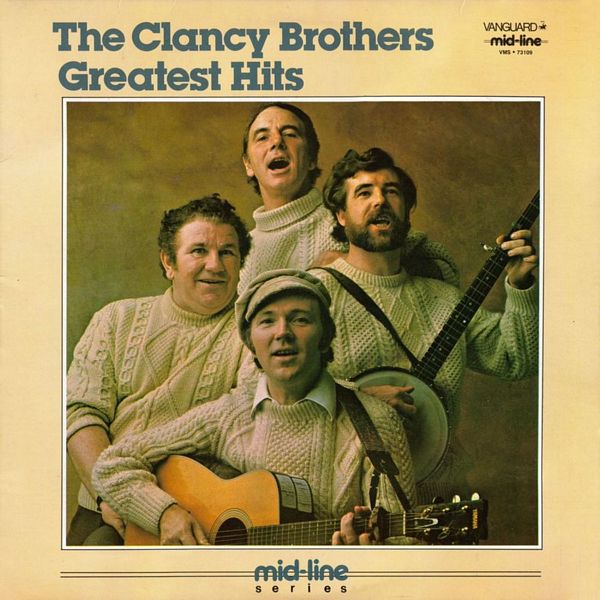

 |
Sleeve Notes
Love, drink, and rebellion, the three pillars of Irish folklore, are also the subjects of the traditional Irish songs that form the repertoire of the Clancy Brothers, the group most responsible for adding an Irish dimension to the American folk revival. Like the fisherman-knit sweaters in which they customarily perform — a costume that did as much for the export of Irish woolens as their performances did for musical traditions — their vocal style is a winning combination of smooth, close harmony with enough rough edges to lend authenticity. They are accompanied by a variety of traditional instruments, including guitar, banjo, concertina, and penny-whistle.
The great irony of the Clancy Brothers' history is that they got their start in the United States, where they were the beneficiaries of the urban folk revival. "It was America showed us Ireland," Tom Clancy recalls. When the group began singing together in the mid-1950s. he continues, "we were singing along with Pete Seeger, Woody Guthrie, Jeanie Ritchie; people like that. They were folk singers, American folk singers, who were reaching into the American past to discover what was real, what was genuine, as compared to the Tin Pan Alley junk. And they got us to look at our own past."
Though not academics, the Clancy Brothers made a concerted effort to search out the old tunes of their homeland. "It wasn't easy," says Tom. "Some of the old songs were no longer sung, even in Ireland. They had been completely submerged by American and English popular music." But find them they did — and what they also found was a portrait of the Irish people.
As Pete Hamill wrote, "the Clancys have given us the music of people who were conquered and betrayed and lied to and deceived, but never finally defeated. It is the music of people who starved on the roads and green fields of Ireland during the Great Famine of the 1840s, while Irish beef was shipped to England; people who died in the stinking holds of transatlantic ships, treated even worse than slaves stolen from Africa … They have given us the songs of the Wild Geese, too, those pining to return to a land at last made free; they have found again the songs of that tempestuous sexuality that is at the true heart of the Irish character, and reminded the Irish that they were not always men and women who bowed to priests. Theirs is a music of stubborn holdouts, of knaves and martyrs and glorious patriotic fools, a music of defeat, and of victims; but a music that forever holds out the glittering promise of ultimate triumph."
Patrick, Tom and Liam Clancy have all worked successfully as actors in the United States since the 1950's. Tom appeared with Orson Welles in King Lear. with Helen Hayes in A Touch of the Poet, and in a portrait of poet Dylan Thomas on CBS-TV's Camera Three. Patrick applied his musical interests to editing and arranging Irish songs for several record companies, and in 1957 founded his own label, Tradition Records. Tommy Makem, whom Liam had discovered singing in a dance hall in Ireland, was the fourth member of the original group. The Clancys and Makem gave their first concert at New York's Circle in the Square about 1954, and soon moved on to the Blue Angel and other leading folk clubs. They did a series of semi-annual concerts at Carnegie Hall, appeared on all the major national television programs, recorded extensively, and were regulars on the American folk circuit.
In the late sixties, the brothers renewed their ties with Ireland, investing in farms and businesses there; Tom staged the International Dublin Folk Festival in 1967. The group subsequently underwent several changes in personnel — Lou Killen was one of the later additions. Though it formally disbanded in the early 1970s, the Clancy Brothers have since regrouped periodically for major concert tours in the U S. and abroad.
— Nancy Toff